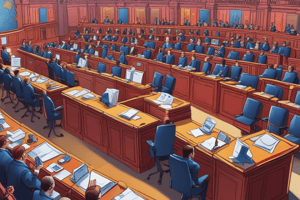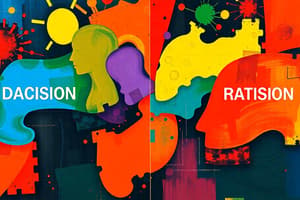Podcast
Questions and Answers
What is the first step in the decision-making process?
What is the first step in the decision-making process?
- Developing alternatives
- Conveying the decision to others
- Identifying the decision criteria
- Defining the decision (correct)
What is a characteristic of a problem according to the text?
What is a characteristic of a problem according to the text?
- It becomes a problem when a manager becomes unaware of it
- There is no pressure to solve the problem
- The manager must have the authority, information, or resources to solve it (correct)
- It is always easy to solve
What does allocating weights to decision criteria involve?
What does allocating weights to decision criteria involve?
- Assigning different levels of importance to criteria (correct)
- Ignoring the importance of criteria
- Assigning equal importance to all criteria
- Balancing the importance of criteria
What does implementing the selected alternative involve?
What does implementing the selected alternative involve?
How is the soundness of a decision judged according to the text?
How is the soundness of a decision judged according to the text?
In which management function does a manager consider the organization's long-term objectives and strategies?
In which management function does a manager consider the organization's long-term objectives and strategies?
When applying game theory, which game is mentioned in the text?
When applying game theory, which game is mentioned in the text?
What is one concept associated with a manager's intuitive decision-making according to the text?
What is one concept associated with a manager's intuitive decision-making according to the text?
What does controlling involve in management?
What does controlling involve in management?
What are some characteristics of problems according to the text?
What are some characteristics of problems according to the text?
What are the 8 steps of the decision-making process?
What are the 8 steps of the decision-making process?
What are the three types of decision-making conditions?
What are the three types of decision-making conditions?
What are the two types of problems and decisions?
What are the two types of problems and decisions?
What are the three decision-making styles?
What are the three decision-making styles?
What are the 12 decision-making biases?
What are the 12 decision-making biases?
What are the 6 characteristics of an effective decision-making process?
What are the 6 characteristics of an effective decision-making process?
Flashcards are hidden until you start studying
Study Notes
Decision-Making Process
- The first step in the decision-making process is to identify the problem.
Problem Characteristics
- A characteristic of a problem is that it is a gap between a current and desired state.
Decision Criteria
- Allocating weights to decision criteria involves assigning importance to each criterion.
Implementing Decisions
- Implementing the selected alternative involves putting the chosen solution into action.
Evaluating Decisions
- The soundness of a decision is judged by its outcome, which is the result of the decision.
Management Functions
- Planning is the management function that involves considering the organization's long-term objectives and strategies.
Game Theory
- The game mentioned in the text when applying game theory is the zero-sum game.
Intuitive Decision-Making
- One concept associated with a manager's intuitive decision-making is instinct.
Controlling
- Controlling involves monitoring and correcting the implementation of a decision.
Problem Types
- Characteristics of problems include being a gap between a current and desired state.
Decision-Making Process Steps
- The 8 steps of the decision-making process are: identifying the problem, generating alternatives, evaluating alternatives, selecting an alternative, implementing the selected alternative, evaluating the outcome, following up, and reviewing the decision.
Decision-Making Conditions
- The three types of decision-making conditions are certainty, risk, and uncertainty.
Problem and Decision Types
- The two types of problems and decisions are structured and unstructured.
Decision-Making Styles
- The three decision-making styles are rational, intuitive, and behavioral.
Decision-Making Biases
- The 12 decision-making biases include confirmation bias, anchoring bias, and availability heuristic, among others.
Effective Decision-Making
- The 6 characteristics of an effective decision-making process are: defining the problem, establishing criteria, weighing criteria, generating alternatives, selecting an alternative, and reviewing the decision.
Studying That Suits You
Use AI to generate personalized quizzes and flashcards to suit your learning preferences.




